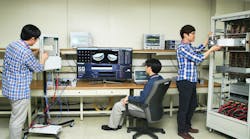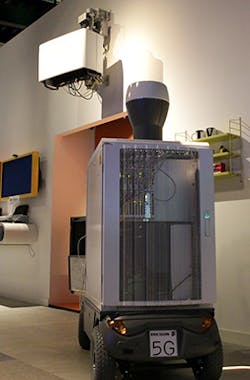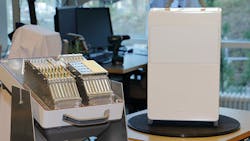Samsung Electronics said it has made smaller and more efficient parts for fifth-generation, or 5G, wireless networks, tackling one of the trickier problems with new wireless standards. The new parts include miniaturized antennas and power amplifiers, both of which can be used inside 5G base stations and devices like smartphones.
The new parts underline the two-front battle that chipmakers and wireless equipment makers are fighting to develop not only 5G standards, but also the hardware to exploit it. 5G technology could prove fast enough to download entire movies in seconds or replace fiber optics in the exhausting chore of linking access points to the internet.
“We are very focused on developing technologies that improve and accelerate the realization of a new generation of mobile networks and devices,” said Paul Kyungwhoon Cheun, who directs 5G projects as the executive vice president of Samsung’s Next Generation Business division.
In a statement, the South Korean chipmaker described the new devices as “5G-ready,” but declined to say when they might be available. According to Samsung, the antennas and power amplifiers work with 28-GHz millimeter waves, which analysts believe will become a major channel for data flowing through 5G.
The new antennas combine dozens of elements into a module less than 1 mm thick, making them ideal for small cell base stations and user devices like smartphones or tablets. Driving each antenna are the new power amplifiers, which can double the output power of signals over earlier parts. According to Samsung, they are also around 50% more power efficient than other prototypes made for 5G.
According to Kungwhoon Cheun, the devices have to be small and highly efficient in order to work with 5G infrastructure. Since millimeter waves can only travel short distances before being absorbed by the atmosphere or blocked by walls, urban networks will have to be built with thousands of small cells on walls and utility poles. The small cells, which will blanket areas with coverage, will require tiny antenna components.
In addition, because of the high throughput of 5G networks, power amplifiers inside small cells and mobile devices must be extremely efficient, in order to keep the cost of signal processing low. Power amplifiers—which boost signals for transmission over the air—are the main source of power consumption in radios.
Over the last few years, making smaller and more efficient parts has taken a back seat to refining how 5G will ride the airwaves. This air interface will handle the difficult task of sending data, compressing and dividing signals into narrow wireless channels. Wireless companies are still ironing out the standard, which will not be completed until around 2019.
The result is that most equipment for diving into 5G networks is bulky and unwieldy, in stark contrast to the small devices and small cells that are rapidly forming the backbone of 5G networks. Increasingly, wireless companies are concerned that not being able to make smaller parts could delay actual 5G service to mobile users. 5G could be deployed as early as 2020.
Chipmakers and wireless equipment makers are trying to prevent what happened with 4G LTE wireless technology. The first networks were installed in Europe in 2009 but the first devices to access these networks were wireless modems, not smartphones, which did not arrive until 2011. That was another year after 4G LTE became available in the United States.
“Up until now, trial equipment has been fairly large, including the cabinet-sized base stations and user devices that must be mounted on the top of a vehicle [for testing]”, said Kyungwhoon Cheun. Last month, for example, Samsung tested small cell handovers with a user equipment bolted on top of an sport utility vehicle.
The new parts are the latest sign that companies are starting to work on more than the air interface. In February, for example, Ericsson revealed its first prototype cell station for 5G networks. The entire station was small enough to be carried around like a briefcase. Only a month before, however, the wireless equipment maker carted around a cabinet-sized version on an electric scooter.
Similar efforts to shrink parts could take shape once the 3G Partnership Project starts accepting proposals on the air interface in 2017. At that point, wireless companies could concentrate more on hardware, so that the air interface is not released before chips are available.
Looking for parts? Go to SourceESB.


